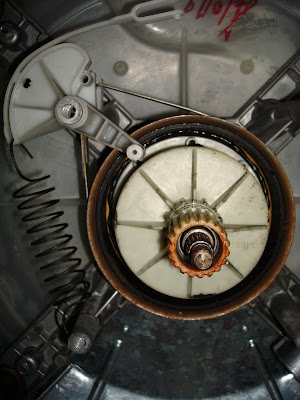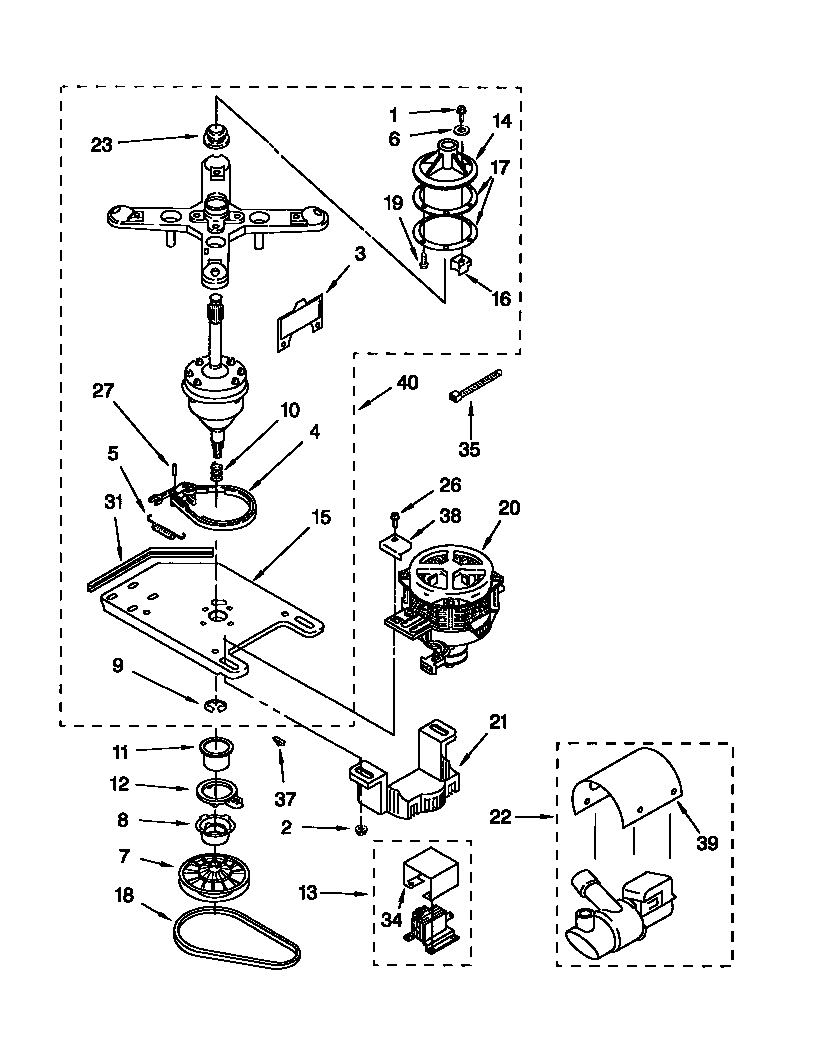|
|
Originally Posted by: kcarnold  Thanks! I received all but the control panel shield today, so I changed out the brake band assembly. The hardest part was getting the new brake band on and the solenoid attachment lock reinserted. Also, remember to put the snubber straps on the right way ;) But sure enough, it stops tamely now! Here are some pictures that might help someone else with a similar machine. One last question: I ordered a replacement pressure sensor tube because the original is gunky and I'd had to cut off some of it, but I can't get the original one disconnected from the basin! It doesn't seem to budge when I pull on it. Any hints? Thanks again. And feel free to change the title of this thread to something more apropos. I'm glad everything went well. The pictures will come in handy for future reference, it will remain in the forum. As for the "stuck" air tube, on the tub, it was probably glued on by the prevoius owner,like the end at the pressure switch. I can only tell you to be very careful in any attempt to remove it. You don't want to "snap off" the connector at the tub,You could try twisting the tube, lightly with a pair of pliers, but very carefully, hopefully it will break loose and you can replace it. Be careful, and have a good day.
|
|
|
Thanks! I received all but the control panel shield today, so I changed out the brake band assembly. The hardest part was getting the new brake band on and the solenoid attachment lock reinserted. Also, remember to put the snubber straps on the right way ;) But sure enough, it stops tamely now! Here are some pictures that might help someone else with a similar machine. One last question: I ordered a replacement pressure sensor tube because the original is gunky and I'd had to cut off some of it, but I can't get the original one disconnected from the basin! It doesn't seem to budge when I pull on it. Any hints? Thanks again. And feel free to change the title of this thread to something more apropos.
|
|
|
Originally Posted by: kcarnold  Well you've sold me; I'll order new brakes, plus the parts to fix the damage, tomorrow. [LIST=1] Is the $47 "brake band" the right part? Does it include the clip that attaches it to the solenoid? (I may have lost that...)
I'm still a bit confused: why would bad brakes stick instead of slipping?
I'm having trouble actually getting the brake band off. What am I missing?
Will I need to re-lubricate any of the drivetrain assembly?[/LIST]Thanks again,
-Ken Ken. Yes, the Brake Band is the right part to order, as to clip you may have lost, I don't believe that will come with the brake band. The brake would stick due to wear and debris build up from the pads themselves, similar to brakes on a automobile(when they squeal)but in this case there is such a build up(not really visible)that the pads grip and lock on the drum instead of it slipping, slowing the revolutions(2 or 3) to a stop. The band does fit tight it will require you to spread the band and raise it up off the drum and spread it again to get it off the gearcase housing, as best I can remember. No, you should not need to re lubricate any of the drive train assembly, you may want to clean the solenoid actuator shaft and make sure it is free moving.
|
|
|
Originally Posted by: Joe / APP Team  Good morning,
The part you would need is only the "brake shoe" assembly,and not the metal ring.
Well you've sold me; I'll order new brakes, plus the parts to fix the damage, tomorrow. [LIST=1] Is the $47 "brake band" the right part? Does it include the clip that attaches it to the solenoid? (I may have lost that...)
I'm still a bit confused: why would bad brakes stick instead of slipping?
I'm having trouble actually getting the brake band off. What am I missing?
Will I need to re-lubricate any of the drivetrain assembly?[/LIST]
Thanks again,
-Ken
|
|
|
Originally Posted by: kcarnold  Alright, I finally got the assembly off to access the brakes:  Do I correctly call the pads between the ring and the shaft "brake shoes"?  (wow, helping the autofocus with a flashlight makes a huge difference in picture quality!) And am I correct to suspect that worn brake shoes are causing the sticking? If so do I need to replace this whole $46 assembly? Is that the whole metal ring too or just the band and shoes? because it seems quite pricy for something so simple. (And I'm certainly not going to buy it without a picture of what I'm getting.) Could I just replace the brake shoes? (I don't have a grinder...) Thanks for your continued help. I probably would have given up and called somebody by now otherwise. I'm still tempted to... Good morning, Thanks for the pictures, a great help. You have found what we're looking for. It would be correct to call the assembly a brake shoe but a parts order person would probably not recognise that term. You would want to use the same terminology as the part description in the parts order screens. The part you would need is only the "brake shoe" assembly,and not the metal ring. I have occasionally cleaned and sanded the pads and the ring with emory cloth, but this is usually only a temporary repair. In some cases it may last as little as 1 month and may last 12. But you may want to give it try, before you purchase the part. Have a good day
|
|
|
Alright, I finally got the assembly off to access the brakes:  Do I correctly call the pads between the ring and the shaft "brake shoes"?  (wow, helping the autofocus with a flashlight makes a huge difference in picture quality!) And am I correct to suspect that worn brake shoes are causing the sticking? If so do I need to replace this whole $46 assembly? Is that the whole metal ring too or just the band and shoes? because it seems quite pricy for something so simple. (And I'm certainly not going to buy it without a picture of what I'm getting.) Could I just replace the brake shoes? (I don't have a grinder...) Thanks for your continued help. I probably would have given up and called somebody by now otherwise. I'm still tempted to...
|
|
|
Originally Posted by: kcarnold  Thanks! I'm increasingly suspecting brakes, because on closer inspection the snubber straps were broken, not disconnected. The solenoid and linkage look and feel fine; I'd have to look at the brake itself to see why it locks up when engaged. Thanks to your Sears reference, I found a gold mine for parts info. But the diagram where I'd expect the brakes to be is unclear. By cross-referencing it to the APP parts pictures, I see I'd need to get underneath the splutch cam, which looks to entail removing a metal plate to which the motor and splutch assembly are all mounted. But it's not clear from the diagrams and pictures which of those pieces actually grab the driveshaft and stop it -- is it the splutch? None of the pieces look like they'll have anything like brake shoes that could apply friction to the driveshaft. Or is the solenoid linkage supposed to only pull the cam part of the way?? If it is possible that taking that assembly apart would reveal something I could fix, what's your estimate on my likelihood of success here? I'm slightly afraid of that spring that counters the brake solenoid; I don't want to loose an eye on account of this fix. Unless it's clear that mucking with the brake assembly will fix the problem for good, I'm inclined to just get another washer. ps - If you're working with a direct drive, this may be interesting... but I don't think it applies to me. No this is not a direct drive unit and wont apply to you. Since you have found the solenoid and brake spring the rest is easy. the brake board assembly '); return false; " style="text-decoration:underline;" href ="http://www.appliancepartspros.com/partsearch.aspx?pn_=  " target="_blank">Part number: 
" target="_blank">
 " border="0" alt="Part number:  " title="Part number:  ">
">
part number 3428323 / item 4, is attached to the solenoid and linkage. Yes you will need to use caution when removing the brake spring. I have not had a problem with them in the past, they look bigger and stronger than they are.I'm confident you should be able to perform this repair using caution and basic tools.
|
|
|
Thanks! I'm increasingly suspecting brakes, because on closer inspection the snubber straps were broken, not disconnected. The solenoid and linkage look and feel fine; I'd have to look at the brake itself to see why it locks up when engaged. Thanks to your Sears reference, I found a gold mine for parts info. But the diagram where I'd expect the brakes to be is unclear. By cross-referencing it to the APP parts pictures, I see I'd need to get underneath the splutch cam, which looks to entail removing a metal plate to which the motor and splutch assembly are all mounted. But it's not clear from the diagrams and pictures which of those pieces actually grab the driveshaft and stop it -- is it the splutch? None of the pieces look like they'll have anything like brake shoes that could apply friction to the driveshaft. Or is the solenoid linkage supposed to only pull the cam part of the way?? If it is possible that taking that assembly apart would reveal something I could fix, what's your estimate on my likelihood of success here? I'm slightly afraid of that spring that counters the brake solenoid; I don't want to loose an eye on account of this fix. Unless it's clear that mucking with the brake assembly will fix the problem for good, I'm inclined to just get another washer. ps - If you're working with a direct drive, this may be interesting... but I don't think it applies to me.
|
|
|
Originally Posted by: kcarnold  Indeed that was very helpful. How would you recommend I access the brake system? Should I just flip the whole thing upside down? The service manual I found inside doesn't cover much below the control unit. You will need to access the brake assembly from the back access panel. Turning the unit upside down, probably wont get you access to the components you're interested in. Mounted to the base of the unit you should find a solenoid assembly with linkage to the brake asembly which encompasses the bottom of the gear case assembly. You would then need to adjust the linkage and check for excessive wear , damage and proper operation of the solenoid. For more indepth information you may want to contact SEARS for a service manual for this particular unit. My information is somewhat limited on older units.
|
|
|
Indeed that was very helpful. How would you recommend I access the brake system? Should I just flip the whole thing upside down? The service manual I found inside doesn't cover much below the control unit.
|